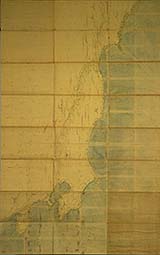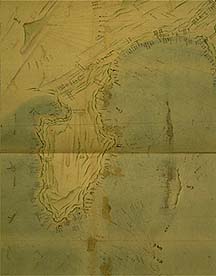Waseda University Library Rare Material Collections
DAINIHON TENMON SOKURYO BUNKEN EZU
by INO Tadataka / Call Number: [ru]11-874
by INO Tadataka / Call Number: [ru]11-874


DAINIHON TENMON SOKURYO BUNKEN EZU
Prod. by INO Tadataka. 1800-1801. 2 maps (217 X 126 cm ; 258 X 163 cm)Waseda University owns two maps produced as the result of INO's surveys of southern Hokkaido and Oshu-Kaido (Tohoku area) in the year 1800, as well as the Izu coast and the eastern coast of Honshu in 1801. The maps not only show the coastal lines, but they also indicate the locations of mountains or post towns, among which red lines are drawn to demonstrate distances of one another. Beginning with the survey in 1800, INO executed coastal surveys throughout Japan for 17 years. In between, on completion of each survey, he lost no time to make a map, which he devoted to the Tokugawa shogunate.
After finishing the surveys all over the country, INO initiated to produce a comprehensive map, which was completed as "Dainihon enkai yochi zenzu" in 1821, after the decease of the surveyor. Having suffered disasters of fire etc, INO's maps are persisting in just a limited number.
The term "bunken ezu" generally means a "plan on a reduced scale" or "plan which is made by consideration of a reduced scale". But its original meaning is a "plan on the scale of 1: 600" (ratio of "bu" to "ken", old Japanese units for length). The scale of the maps introduced here is 1: 216,000.
Though well-known as geographer and surveyor, it was as late as at 51, after retirement from the work, that INO actually began his research. Before that time, he was engaged in his family business of brewing and dealings of rice, with an excellent talent. Serving to the public interest as a village head, he devoted himself, as the story goes, to relieve the poor by his own property, particularly during the Tenmei Famine (1782-1787), one of the worst calamities in the Edo period, affected by floods of the Tone River and by the great eruption of the Asama Mountain. His life can be called an incarnation of the saying, "It's not too late to learn."
- INO Tadataka1745-1818. Surveyor in the middle Edo period. After retirement, he became a pupil of the astronomer TAKAHASHI Yoshitoki, who was 19 years younger than himself, and learned Western astronomy and other subjects. Besides the "INO Maps", his works include books of mathematics and surveying, such as "Kyukatsu en hassenho" or "Chikyu sokuenjutsu mondo".